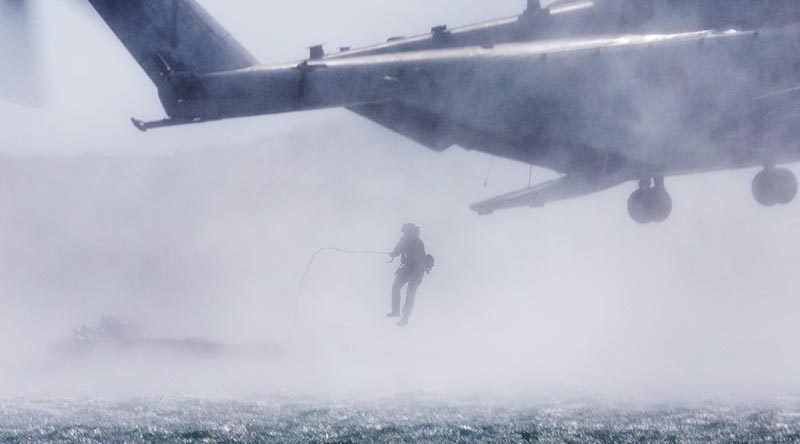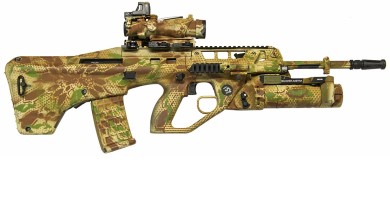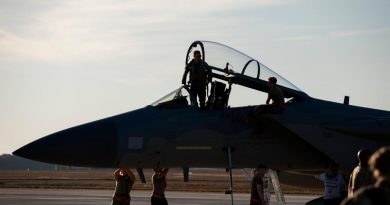2RAR add helocasting to their skill sets

Australia took a leap forward in amphibious capability recently as 2nd Battalion (Amphibious), Royal Australian Regiment (2RAR (Amphib)) soldiers released small boats into the ocean from a moving US Marine Corps CH-53 helicopter during the Rim of the Pacific – RIMPAC – exercise held in waters off the coast of Oahu, Hawaii.
CAPTION: An Australian Army soldier from 2RAR (Amphib) jumps from a US Marine Corps CH-53E Super Stallion helicopter into open water during Exercise RIMPAC. Photo by Corporal Kyle Genner.
It was an accomplishment for the Australian soldiers as they proved themselves capable of helocasting – a water insertion method for reconnaissance and surveillance missions.
Commanding Officer 2RAR (Amphib) Lieutenant Colonel Doug Pashley said that in the Australian Army, helocasting was only employed by Special Operations units.
“We have been on the journey of delivering a world-class pre-landing force since the start of the year and, in just six months, we have come a long way,” Lieutenant Colonel Pashley said.
“On this exercise we have demonstrated an amphibious capability that did not exist in the conventional army until today.
“It would not have been possible without the tremendous support from our US counterparts.”
As part of the Force Integration Training (FIT) phase, the soldiers spent two days honing their skills alongside US Marines from the 3rd Marine Expeditionary Force (III MEF).
Training involved loading fully inflated FC470 Zodiacs into the heavy-lift helicopter, pushing the boats out the back and leaping into the water after them, from a height of 5 to 10 feet and an airspeed of 8 to 10 knots.
Earlier this year, with the assistance of both Special Operations Command and the 5th Aviation Regiment, 2RAR (Amphib) developed their helocast capability.
This was further progressed during Exercise Sea Series and now during RIMPAC, the amphibious specialists have for the first time, incorporated combat equipment and small boats.
After a number of successful helocasts into the water, Lieutenant Colonel Pashley said 2RAR, US, Indonesian and Japanese soldiers validated their skills in the Pacific Ocean as part of a full mission profile.
“Rough waters proved challenging as the soldiers contended with ocean swells of up to 6 feet, swam to their boats and manoeuvred ashore for a reconnaissance mission,” he said.
![]()
Drop Zone Master, III MEF Gunnery Sergeant Dante Collins was impressed by 2RAR’s effort.
“Out of six runs, every single one of them got progressively better – they’ve been knocking it out of the park,” Gunnery Sergeant Collins said.
While 2RAR (Amphib) took every opportunity to learn from the experienced Marines, Gunnery Sergeant Collins said the learning experience had been a two-way exchange.
“In the week that I’ve been training with 2RAR, I’ve pulled a lot of techniques from the Aussies and they’ve drawn a lot of techniques from us,” he said.
“Moving into the next phase, we are going to be successful because of the techniques we have shared during this training.”
On completion of RIMPAC, Australia’s amphibious force will look to introduce the capability back home, Lieutenant Colonel Pashley said.
“We now have the training package, the standard operating procedures and experience to bring this back and incorporate it into the Australian Army.
“I am confident that in the second half of this year we will be able to replicate the success we have had here during RIMPAC.”
Twenty-five nations, 46 ships, five submarines, about 200 aircraft, and 25,000 personnel are participating in RIMPAC from June 27 to August 2, in and around the Hawaiian Islands and southern California.
RIMPAC 2018 is the 26th exercise in the series that began in 1971.
.
.
.
.
.
.

.
.





